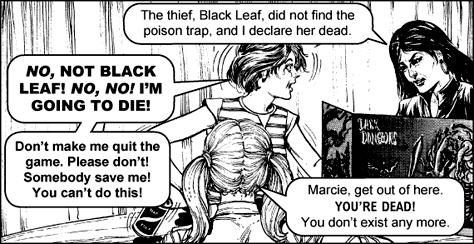One of the big things in the D&D world last year was the [combat wheelchair]. There were a lot of arguments over it. I never saw the point. It’s not just I didn’t see the point of the arguments. I didn’t see the point of the wheelchair. Unlike some people, I have no strong objections to it, although it is something I don’t think I’d allow in most D&D campaigns I would run. As designed, it is just too powerful a magical item 1 to have in players’ hands from day one.
Still, if someone else wanted to allow it in my game I viewed it as I view pretty much anything this side of F.A.T.A.L. If people want to play their game that way, it is their game. As Wylock says, “Make things; play games; have fun.”
Yet the level of flame wars over the combat wheelchair was frightening. I wasn’t surprised by some of the accusations hurled from the pro-wheelchair side. I’m used to be called an istaphobe for just about any opinion, so being called ablist over what kind of magic items I thought appropriate for beginning PCs in a D&D campaign to have was no surprise. The accusations from the anti-wheelchair side struct me more.
Then, about a month ago, a video by the RPG Pundit 2 contained a statement that crystalized everything I was missing. The entire disagreement, including my inability to see the artifact’s point, came down to a fundamental disagreement about RPG philosophy. The people behind the wheelchair and I have a philosophical disagreement, not about the place of the disabled in the world, be it the real world or our constructed worlds of fantasy.

We have a disagreement about the relationship between the player and the character. While it is a gross simplification, I would boil it down to one idea. I see the character as something separate from the player. Those who so strongly advocated for the combat wheelchair see the character as an extension of the player.
Note, these philosophical differences do not need to overlap with over differences. It might seem like this would map on to “role vs. roll” playing debates or on preference for director or author stance versus actor stance. I do not think they do. It is possible to view the character as your playing piece in a game world and view it as an extension of you. It is possible to see the character as someone separate from you, but still think of yourself as inhabiting them while playing.
The core difference between the two things is how you see the aspects of the character as reflecting aspects of you, the player, and how you see the world’s reaction to the character as a reaction to you, the player. I am close to the complete disconnect of these things. It seems many players, especially those who came into the hobby in the past decade or two, are nearly the exact opposite.
In retrospect, this should have been obvious. There was a reoccurring phrase in the discussion that should have been a tip-off. Variations on “I finally see someone like myself in D&D” abounded in the discussion. The need for better player representation in gaming art is nothing new. When it comes to illustrations of players and groups I suspect the art in newer games is more diverse than the actual hobby, especially in terms of race, but probably sex as well. Some companies seem to have taken the idea to the point of parody. However, having wheelchaired players in-game illustrations wasn’t satisfying the need.
Players wanted to see themselves not at the table playing D&D but was the people in the game of D&D. If they wrote a Joel Rosenberg style book about themselves the character they would be when transported into the fantasy world would bring everything about them into the game world. A gym rat would not lose their gym body when translated into the bookish wizard they were playing. A bubbly cheerleader type would not take a hit to her charisma when transported into Greyhawk as a half-orc.
A paraplegic would not gain functioning legs when they were remembered in the Forgotten Realms.
I will admit I still don’t grok that stance. While I’ve played plenty of D&D in the “this is how I would behave if I were a fighting-man/magic-user/cleric in a world of dungeons” mode of playing yourself, I have never wanted or needed core parts of my identity, from my faith to my nearsightedness, to be available to every character I played.
Self-insert has had strong backing from the beginning of the hobby in one form. Back in the late 70s and early 80s, a variety of games meant to be “play yourself” appeared. Villains and Vigilantes and Timeship3 come to mind. Aftermath discusses it as an option. More recently, Fantasy Flight Games published their End of the World line of RPGs. I own Wraith of the Gods from the series. Yet, even with these, I tend to prefer alternate rules allowing you to generate characters.
I’m not saying I’m any kind of hardcore roleplayer. On the classic “Real Men, Real Roleplayers, Real Loonies, Real Munchkins” categorization, I’m probably half Real Man and half Real Loonie. What I will say is that the model of that wonderful parody and its descendants doesn’t stray too far from how I’ve seen nearly every style of roleplaying I’ve encountered in over 40 years of the hobby. That is, until now.
Now that I think about it, the other major style I have never understood I also had a hard time fitting into that model. That style is the bully. I’m not talking about someone who plays a character who is a bully to NPCs and sometimes the pcs. I’m talking about people whose playstyle is to bully others at the table, both in character and out of character.
I think a lot of the vehemence against the wheelchair happened because that was the lense people who didn’t get it, mostly people who have been in the hobby a long time, saw it. They saw it as another avenue for bully players to abuse their GMs. There was some legitimacy to this given many of the early champions of the combat wheelchair, including those most likely to use the ablist tag on people who didn’t want it in their games, have a history of using the hobby to bully others in the name of DIE.
Casting all the players interested in the combat wheelchair in that light is unfair and unwise. That is not what is happening. I think what is happening is we have a generational difference, not so much in age (although there as well), but gaming generation. The players with less than ten or fifteen years under their belt are much less likely to have a strong separation of themselves personally than those of us with thirty-plus years are. At the risk of being mildly negative, we have a generation of Black Leafs. We need to accept them on that level and just be clear about our style of play when in games with them.

So, to the players who want to both play in my game and have a combat wheelchair in order to see themselves in the game, I can understand I understand your goal on an intellectual level. I won’t say I grok it.
I also won’t say that I’d blanket allow it in my game. Some games I would. The wheelchair would fight right into Gilanta and maybe Alphatia in Mystera. I’d probably work something out with you in those settings, although I’d want to convert it to a leveling magic item instead of the standard write-up.
Beyond that, though, our philosophies of roleplaying are mismatched. I run games that about a secondary reality with its own people in it, who may or may not reflect the nature of the person running them. That is the framework for the stories I want to tell. You’re welcome to join them. If you don’t want to, I wish you luck in games that feed your soul and its needs.
- It brings abilities similar to a warhorse, the notable exception being additional carrying capacity, to the character as well as a tool proficiency and limited immunity to stair related traps and combat hazards without many of the limitations of the warhorse for half the cost. Even at its design cost, it is beyond the normal ability of level 1 characters to buy.[↩]
- the Final Boss in Internet Shitlords[↩]
- see the wonderfully fun coverage of this game at the Save for Half podcast[↩]


Be First to Comment